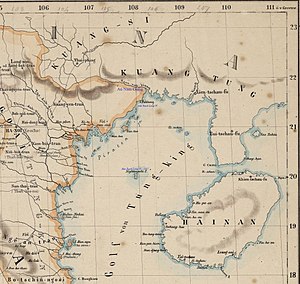Anglo-Vietnamese conflict (1808)
| Anglo-Vietnamese conflict | |||||||
|---|---|---|---|---|---|---|---|
| Part of the Napoleonic Wars | |||||||
 Environment of the Gulf of Tonkin | |||||||
| |||||||
| Belligerents | |||||||
|
| |||||||
| Commanders and leaders | |||||||
|
|
| ||||||
| Strength | |||||||
| 10 warships | |||||||
| Casualties and losses | |||||||
| several sunk and damaged | |||||||
The Anglo-Vietnamese conflict was a short skirmish between the British Royal Navy and the Vietnamese Royal navy in 1808. The small British fleet of ten ships was on their way from India to Portuguese Macao, but arrived in the Gulf of Tonkin instead, showing up their force there and engaging with the Vietnamese navy.[1]
Background[edit]
Nguyen Anh, the founder and the ruling emperor of the Kingdom of Vietnam, had signed an alliance treaty with King Louis XVI of France while he was in Europe in 1787, seeking support for his struggle against the Taysons. Although France failed to aid Nguyen Anh, thousands of French advisors, officers, and mercenary soldiers continued to help the Nguyen loyalists battle against the Taysons. The former achieved the final victory in July 1802 as Nguyen Anh became the first monarch of unified Vietnam.[2]
On 4 December 1803, British envoy John William Roberts from Guangzhou arrived in Da Nang and met Gia Long's two mandarins. One of them was Philippe Vannier, who had built a powerful navy for Gia Long. Roberts tried to convince Gia Long to abandon his pro-French attitude and open his kingdom to British trade, but failed.[3]
Conflict and aftermath[edit]
In April 1808, the British dispatched Admiral William O'Bryen Drury and 10 vessels to the South China Sea. Fearing that Napoleon would use the Franco-Vietnamese tie and help the Nguyen navy, an act that could disrupt the British trade in Southeast Asia, Britain decided to attack Vietnam. Arriving in the Gulf of Tonkin, Drury planned to plot up the Red River, seizing Hanoi in rapid pace and force Gia Long to conciliate. British assault however was halted by smaller Vietnamese junk ships and several ships were destroyed or damaged.[4] About 6 to 7 ships were sunk and burned.[5] Drury was forced to return to Macao.[6]
Vietnamese royal archives didn't mention a British attack in 1808, although they did report about British delegations in 1804 and 1822.
Footnotes[edit]
- ↑ Ngaosyvathn, Mayoury; Pheuiphanh Ngaosyvathn (1998). Paths to Conflagration: Fifty Years of Diplomacy and Warfare in Laos, Thailand, and Vietnam, 1778–1828. Ithaca, New York: Cornell University Press. p. 109. ISBN 0-87727-723-0. Search this book on

- ↑ Mikaberidze 2020, p. 487.
- ↑ Meybon, C. M. 1906. Les Anglais à Macao en 1802 et 1808. BEFEO 6:301–325. p. 313
- ↑ Meybon, C. M. 1906. Les Anglais à Macao en 1802 et 1808. BEFEO 6:301–325. p. 314
- ↑ Ngaosyvathn, Mayoury; Pheuiphanh Ngaosyvathn (1998). Paths to Conflagration: Fifty Years of Diplomacy and Warfare in Laos, Thailand, and Vietnam, 1778–1828. Ithaca, New York: Cornell University Press. p. 109. ISBN 0-87727-723-0. Search this book on

- ↑ Meybon, C. M. 1906. Les Anglais à Macao en 1802 et 1808. BEFEO 6:301–325. p. 315
References[edit]
- Crawfurd, John (1828). Journal of an Embassy from the Governor-General of India to the Courts of Siam and Cochin China: Exhibiting a View of the Actual State of Those Kingdoms. H. Colburn. Search this book on

- Lamb, Alastair (1970). The Mandarin Road to Old Hué: Narratives of Anglo-Vietnamese Diplomacy from the 17th Century to the Eve of the French Conquest. Archon Books. ISBN 978-0-20801-036-0. Search this book on

- Mikaberidze, Alexander (2020). The Napoleonic Wars: A Global History. Oxford University Press. ISBN 978-0-199-39406-7. Search this book on

This article "Anglo-Vietnamese conflict (1808)" is from Wikipedia. The list of its authors can be seen in its historical and/or the page Edithistory:Anglo-Vietnamese conflict (1808). Articles copied from Draft Namespace on Wikipedia could be seen on the Draft Namespace of Wikipedia and not main one.



